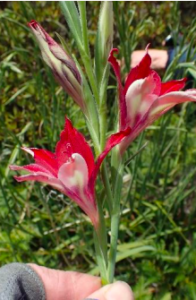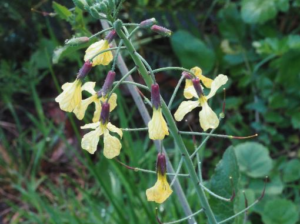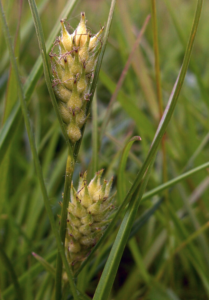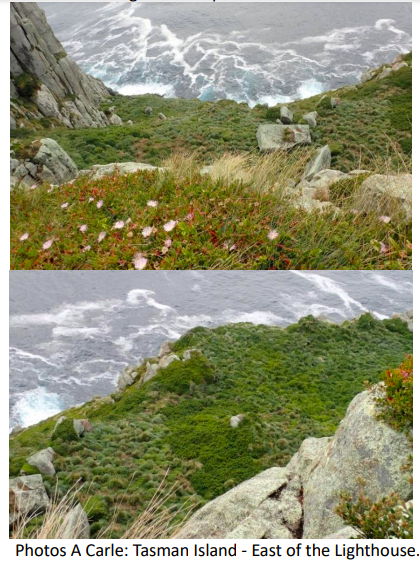In search of the Tasman Island Cricket, Flora Follow-up & Californian Thistle Eradication on Tasman Island
Report on project completed with funding from the Tasmanian Nature Conservation Fund
Californian Thistle Eradication and other weed work:
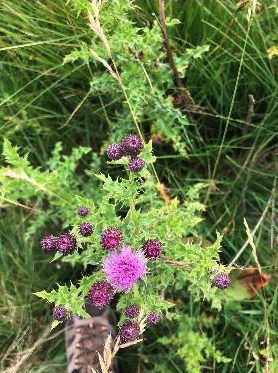 Our aim is to eradicate these thistles from the island. We are almost there!
Our aim is to eradicate these thistles from the island. We are almost there!
At the last Spring working bee in November 2022, we treated (with Lontrel Advanced) a total of 662 thistles. An additional Working Bee in January has been added to our program to achieve our eradication aim. The number of thistles sprayed have been on a downward trajectory since a peak of 8,722 in April 2021!
See this Report by Brett Hall.
Flora Follow up work including Carex hirta work – by Annabel Carle
The Tasmanian Herbarium staff have now identified the Tasman Island plant specimens collected during the Nov/Dec 2023 working bee.
The updated Flora report can be found at this link for your information and reference.
Note: Appendix 1 and the Tasman Island plant species list at 30 Jan referred to within the Report can be found at the following links:
- Appendix-1-Tasman-Is-Herbarium-specimens-collected-Nov-23-Dec1-2023.pdf
- Tasman-Island-species-list-at-30-Jan-2024.pdf
A comprehensive plant species list can be found here.
- Scarlet Gladioli, Gladioli x colvillii by A Carle
- Wild radish, Raphanus raphanistrum
- Hairy sedge, Carex hirta
In search of the Tasman Island Cricket in their natural habitat – by Amanda Thomson
FOTI’s November trip involved searching for the Tasman Island Cricket, Tasmanoplectron isolatum (Rhaphiphoridae). After finding a live specimen in one of the houses in January of 2023, I was keen to explore the location of the crickets in their natural habitat, hoping to get an idea of the number and locations of this endemic species. I consulted with Entomologists, and previous lighthouse Keepers who were helpful, but little is known about these crickets.
Following the Hamish Saunders Memorial Island Survey Program of 2005 Report of Elliot traps catching Tasman Island Crickets in She-oak Woodland, Dr Simon Grove from TMAG kindly lent a number of Elliot Traps for ‘catching’ specimens. These are long, oblong metal boxes, containing a sprung plate.
Traps were baited with Peanut butter and oats, then laid out in 8 different locations dependent on weather, wind, accessibility, and vegetation types. With at least 2 in each location, they were left over two nights and checked each following day, (bar one due to very inclement weather – wet and windy and close proximity to the cliff face). There were no signs of activity in any of the traps, except some ants feeding on the peanut butter. In the last couple of days, I also used a plastic bottle trap and only collected a scarab beetle and small moth.
Traps were located next to the Oil Store and where the Radio room had been – and where anecdotally, the crickets were seen in large numbers at dusk and before sunrise. They were also placed next to cliff tops and cavernous cracks where I thought they may be hiding (southeast of the lighthouse; directly east of Q3 on the edge of the rocky promontory; and north on the cliff- face cracks near the old tip).
Other locations were; She-oak woodland at the beginning of the Zig-zag track, and out to the west amidst large She-oaks. In desperation I placed some back in the same building where one was found in January – in the same room and out on the verandah with underfloor and dark places to hide. Not even the Cave Cricket Parvotettix fortescuensis, found aplenty in January, was collected.
Perhaps those caught in 2005 in She-oak woodland were accidental bycatches. Furthermore, Elliot traps are not, we suspect, sensitive enough to trap a light-weight cricket. A different ‘lure’ to peanut butter should be trialled. ‘Much food for thought’.
A big thanks to the Tasmanian Nature Conservation Fund and the dedicated volunteers who made this project possible:
*Annabel Carle, Botanist: 130 hours including 60 hours report writing post working bee.
* Brett Hall, Weeding leader: 76 hours including 16 hours report writing post working bee.
*Amanda Thomson; Field Naturalist: 63 hours and 3 hours report writing post working bee.
* Martin O’Brian, Weeding assistant 56 hours
